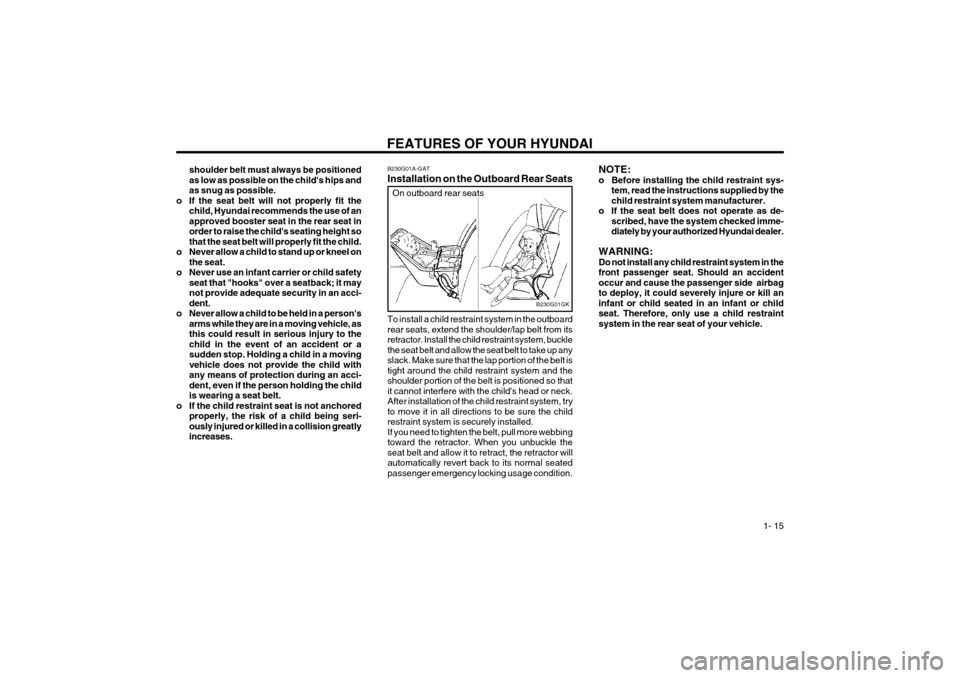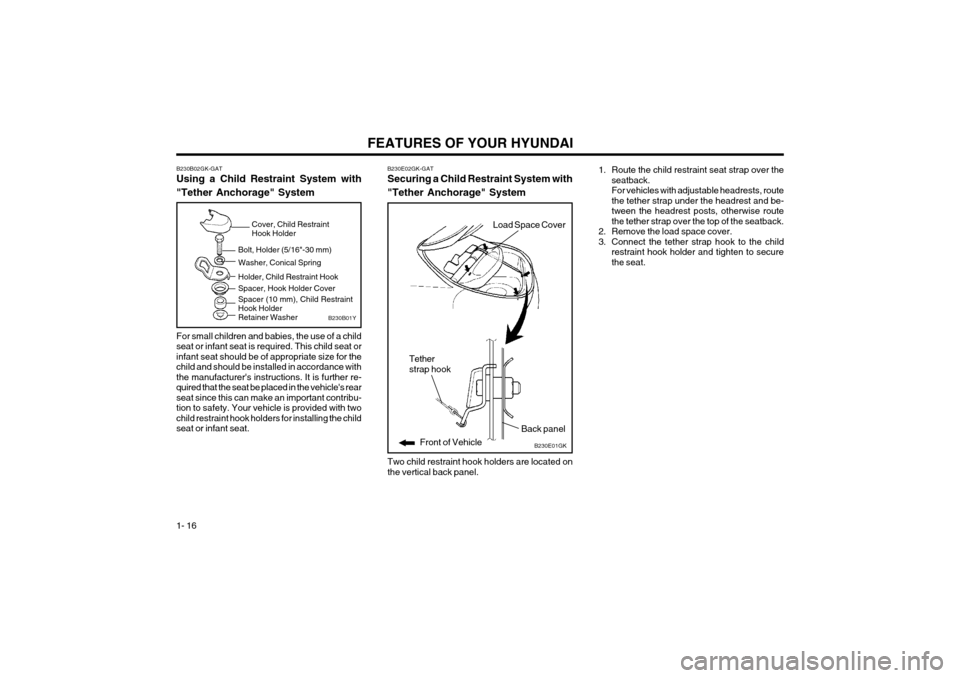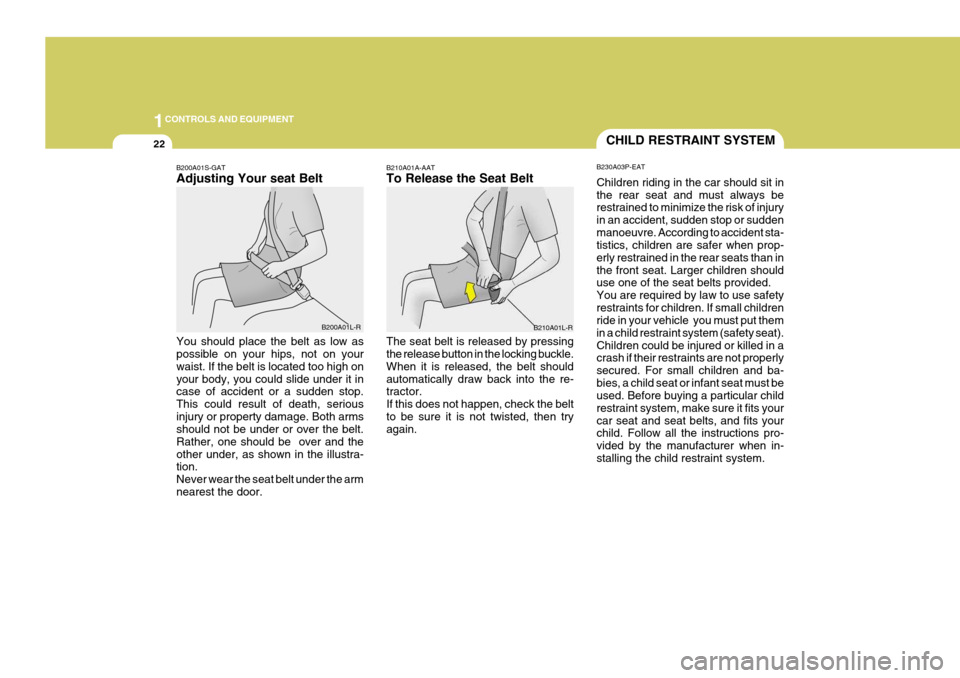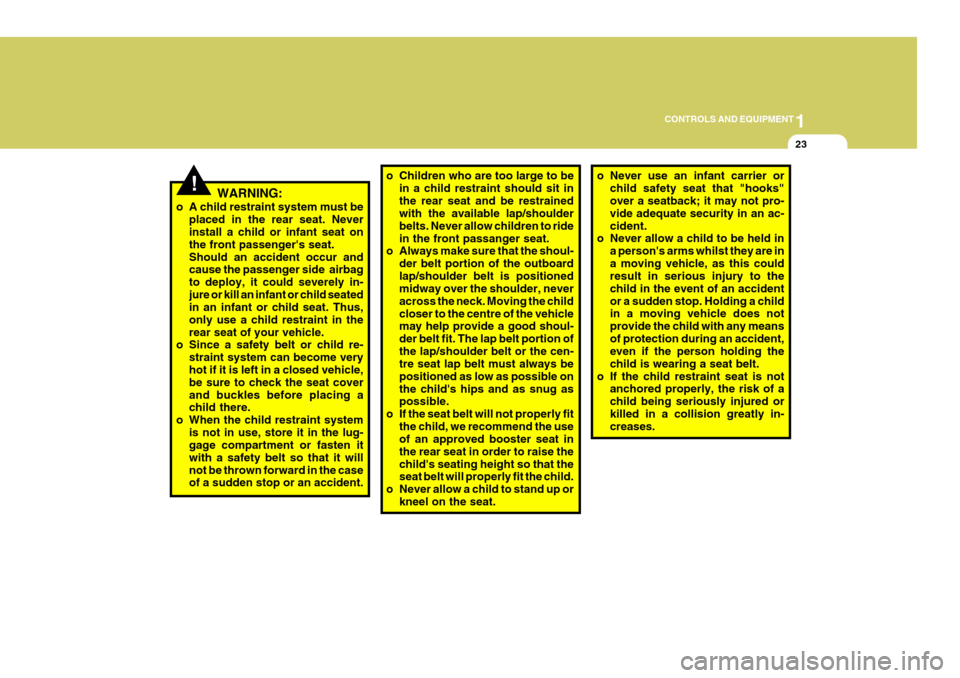2004 Hyundai Coupe Infant
[x] Cancel search: InfantPage 19 of 389

FEATURES OF YOUR HYUNDAI 1- 11
B150C02A-AAT Larger ChildrenChildren who are too large for child restraint systems should always occupy the rear seat anduse the available lap/shoulder belts. The lapportion should be fastened snug on the hips andas low as possible. Check belt fit periodically. Achild's squirming could put the belt out of posi-tion. Children are afforded the most safety in theevent of an accident when they are restrained bya proper restraint system in the rear seat. If alarger child (over age 13) must be seated in thefront seat, the child should be securely restrainedby the available lap/shoulder belt and the seatshould be placed in the rearmost position. Chil-dren under the age of 13 should be restrainedsecurely in the rear seat. NEVER place a childunder the age of 13 in the front seat. NEVERplace a rear facing child seat in the front seat ofa vehicle. B150D01A-AAT Pregnant WomenThe use of a seat belt is recommended for pregnant women to lessen the chance of injury inan accident. When a seat belt is used, the lap beltportion should be placed as low and snugly aspossible on the hips, not across the abdomen.For specific recommendations, consult a physi-cian.
WARNING:The purpose of the fold-down rear seatbacksis to allow you to carry longer objects thancould otherwise be accommodated. Neverallow passengers to sit on top of the foldeddown seat back while the car is moving asthis is not a proper seating position and noseat belts are available for use. This couldresult in injury in case of an accident orsudden stop. Objects carried on the foldeddown seatback should not extend higher thanthe top of the front seats. This could allowcargo to slide forward and cause injury ordamage during sudden stops.
B150A02A-GAT SEAT BELT PRECAUTIONS All occupants of the vehicle should wear their
seat belts at all times. Indeed, your province'slaws may require that some or all occupants ofthe vehicle use seat belts.The possibility of injury or the severity of injury inan accident will be decreased if this elementarysafety precaution is observed. In addition, followthe other instructions provided in this section. B150B01A-GAT Infant or Small Child Some countries require the use of child restraint systems for infants and small children. Whetherthis is required by law or not, it is stronglyrecommended that a child restraint seat or infantrestraint system be used for infants or small
children weighing less than 18 kilograms (40pounds).
B140A01S-AAT REAR SEAT WARNING
B140A01GK
For the safety of all passengers, luggage or other
cargo should not be piled higher than the top of
the seatback. In addition, do not place objects on
the rear shelf as they may move forward during braking or in an accident and strike vehiclepassengers.
Page 22 of 389

FEATURES OF YOUR HYUNDAI
1- 14 WARNING:
o A child restraint system must be placed in
the rear seat. Never install a child or infantseat on the front passenger's seat.Should an accident occur and cause thepassenger side airbag to deploy, it couldseverely injure or kill an infant or childseated in an infant or child seat. Thus, onlyuse a child restraint in the rear seat of yourvehicle.
o Since a safety belt or child restraint sys- tem can become very hot if it is left in aclosed vehicle, be sure to check the seatcover and buckles before placing a childthere.
o When the child restraint system is not in use, store it in the trunk or fasten it with asafety belt so that it will not be thrownforward in the case of a sudden stop or anaccident.
o Children who are too large to be in a child restraint should sit in the rear seat and berestrained with the available lap/shoulderbelts. Never allow children to ride in thefront passenger seat.
o Always make sure that the shoulder belt portion of the outboard lap/shoulder beltis positioned midway over the shoulder,never across the neck or behind the back.Moving the child closer to the center of thevehicle may help provide a good shoulderbelt fit. The lap belt portion of the lap/
B210A01A-AAT To Release the Seat Belt The seat belt is released by pressing the release button in the locking buckle. When it is released,the belt should automatically draw back into theretractor.If this does not happen, check the belt to be sureit is not twisted, then try again.
FUA1090R
B230A03A-GAT CHILD RESTRAINT SYSTEM (If Installed) Children riding in the car should sit in the rear seat and must always be properly restrained tominimize the risk of injury in an accident, suddenstop or sudden maneuver. According to accidentstatistics, children are safer when properly re-strained in the rear seats than in the front seat.Larger children not in a child restraint should useone of the seat belts provided.You are required by law to use safety restraintsfor children. If small children ride in your vehicleyou must put them in a child restraint system(safety seat).Children could be injured or killed in a crash iftheir restraints are not properly secured. Forsmall children and babies, a child seat or infantseat must be used. Before buying a particularchild restraint system, make sure it fits your carseat and seat belts, and fits your child. Follow allthe instructions provided by the manufacturerwhen installing the child restraint system.
Page 23 of 389

FEATURES OF YOUR HYUNDAI 1- 15
B230G01A-GAT Installation on the Outboard Rear Seats
B230G01GK
On outboard rear seats
To install a child restraint system in the outboard rear seats, extend the shoulder/lap belt from itsretractor. Install the child restraint system, bucklethe seat belt and allow the seat belt to take up anyslack. Make sure that the lap portion of the belt istight around the child restraint system and theshoulder portion of the belt is positioned so thatit cannot interfere with the child's head or neck.After installation of the child restraint system, tryto move it in all directions to be sure the childrestraint system is securely installed.If you need to tighten the belt, pull more webbingtoward the retractor. When you unbuckle theseat belt and allow it to retract, the retractor willautomatically revert back to its normal seatedpassenger emergency locking usage condition.
shoulder belt must always be positionedas low as possible on the child's hips andas snug as possible.
o If the seat belt will not properly fit the child, Hyundai recommends the use of anapproved booster seat in the rear seat inorder to raise the child's seating height sothat the seat belt will properly fit the child.
o Never allow a child to stand up or kneel on the seat.
o Never use an infant carrier or child safety seat that "hooks" over a seatback; it maynot provide adequate security in an acci-dent.
o Never allow a child to be held in a person's arms while they are in a moving vehicle, asthis could result in serious injury to thechild in the event of an accident or asudden stop. Holding a child in a movingvehicle does not provide the child withany means of protection during an acci-dent, even if the person holding the childis wearing a seat belt.
o If the child restraint seat is not anchored properly, the risk of a child being seri-ously injured or killed in a collision greatlyincreases. NOTE:
o Before installing the child restraint sys-
tem, read the instructions supplied by thechild restraint system manufacturer.
o If the seat belt does not operate as de- scribed, have the system checked imme-diately by your authorized Hyundai dealer.
WARNING:Do not install any child restraint system in thefront passenger seat. Should an accidentoccur and cause the passenger side airbagto deploy, it could severely injure or kill aninfant or child seated in an infant or childseat. Therefore, only use a child restraintsystem in the rear seat of your vehicle.
Page 24 of 389

FEATURES OF YOUR HYUNDAI
1- 16 1. Route the child restraint seat strap over the
seatback. For vehicles with adjustable headrests, routethe tether strap under the headrest and be-tween the headrest posts, otherwise routethe tether strap over the top of the seatback.
2. Remove the load space cover.
3. Connect the tether strap hook to the child restraint hook holder and tighten to securethe seat.
B230B02GK-GAT Using a Child Restraint System with "Tether Anchorage" System For small children and babies, the use of a child seat or infant seat is required. This child seat orinfant seat should be of appropriate size for thechild and should be installed in accordance withthe manufacturer's instructions. It is further re-quired that the seat be placed in the vehicle's rearseat since this can make an important contribu-tion to safety. Your vehicle is provided with twochild restraint hook holders for installing the childseat or infant seat.
B230B01Y
Cover, Child Restraint Hook Holder
Bolt, Holder (5/16"-30 mm) Washer, Conical Spring
B230E01GK
Back panel
Front of Vehicle
Tether strap hook
B230E02GK-GAT Securing a Child Restraint System with "Tether Anchorage" System Two child restraint hook holders are located on the vertical back panel.
Load Space Cover
Holder, Child Restraint Hook Spacer, Hook Holder Cover Spacer (10 mm), Child Restraint Hook Holder Retainer Washer
Page 29 of 389

FEATURES OF YOUR HYUNDAI 1- 21
B240B01GK-GAT SRS Components and Functions The SRS consists of the following components: - Driver's Airbag Module - Passenger's Airbag Module- SRS Service Reminder Indicator (SRI)- SRS Control Module (SRSCM) The SRSCM continually monitors all elements while the ignition is "ON" to determine if a frontalor near-frontal impact is severe enough to re-quire airbag deployment. The SRS service reminder indicator (SRI) on the instrument panel will blink for about 6 secondsafter the ignition key is turned to the "ON" positionor after the engine is started, after which the SRIshould go out.
o Do not tamper with or disconnect SRS
wiring, or other components of the SRSsystem. Doing so could result in injury,due to accidental firing of the airbags orby rendering the SRS inoperative.
o Do not install a child restraint system in the front passenger seat position. A childrestraint system must never be placed inthe front seat. The infant or child could beseverely injured or killed by an airbagdeployment in case of an accident.
o Do not allow children to ride in the front passenger seat. If older children (teenag-ers and older) must ride in the front seat,make sure they are always properly beltedand that the seat is moved back as far aspossible.
o For maximum safety protection in all types of crashes, all occupants including thedriver should always wear their seat beltswhether or not an airbag is also providedat their seating position to minimize therisk of severe injury or death in the eventof a crash. Do not sit or lean unnecessarilyclose to the airbag while the vehicle is inmotion.
o The SRS airbag system must deploy very rapidly to provide protection in a crash. Ifan occupant is out of position because ofnot wearing a seat belt, the airbag mayforcefully contact the occupant causingserious or fatal injuries.
B240B01L
The airbag modules are located both in the center of the steering wheel and in the frontpassenger's panel above the glove box. Whenthe SRSCM detects a considerable impact to thefront of the vehicle, it will automatically deploy theairbags. CAUTION: Do not install or place any accessories (drinkholder, cassette holder, sticker, etc) on thefront passenger's panel above the glove boxin a vehicle with a passenger's air bag. Suchobjects may become dangerous projectilesand cause injury if the passenger's air baginflates.
B240B02L
Upon deployment, tear seams molded directly into the pad covers will separate under pressurefrom the expansion of the airbags. Further open-ing of the covers then allows full inflation of theairbags.
Page 32 of 389

FEATURES OF YOUR HYUNDAI
1- 24 o Do not tamper with or disconnect SRS
wiring, or other components of the SRS system. Doing so could result in injury,due to accidental firing of the airbags orby rendering the SRS inoperative.
o If components of the airbag system must be discarded, or if the vehicle must be
scrapped, certain safety preca utions must
be observed. Your Hyundai dealer knowsthese precautions and can give you the
necessary information. Failure to followthese precautions and procedures could
increase the risk of personal injury.
o If you sell your vehicle, be sure to inform the new owner of these important pointsand make certain that this manual is trans-ferred to the new owner.
o If your car was flooded and has soaked carpeting or water on flooring, youshouldn't try to start engine; have the car
towed to authorized Hyundai dealer.
WARNING:
o Do not install a child restraint system in
the front passenger seat position.
A child restraint system must never be placed in the front seat. The infant or childcould be severely injured by an airbagdeployment in case of an accident.
o Extreme Hazard! Do not use a reward facing restraint on a seat protected by anairbag in front of it!
o Modification to SRS components or wir- ing, including the addition of any kind ofbadges to the pad covers or modifications
to the body structure, can adversely affectSRS performance and lead to possibleinjury.
o For cleaning the airbag pad covers, use only a soft, dry cloth or one which hasbeen moistened with plain water. Solventsor cleaners could adversely affect theairbag covers and proper deployment ofthe system.
o No objects should be placed over or near the airbag modules on the steering wheel,instrument panel, and the frontpassenger's panel above the glove box,because any such object could cause harmif the vehicle is in a crash severe enoughto cause the airbags to inflate.
o If the airbags inflate, they must be re- placed by an authorized Hyundai dealer.
Page 202 of 389

1CONTROLS AND EQUIPMENT
22
B210A01A-AAT To Release the Seat Belt The seat belt is released by pressing the release button in the locking buckle. When it is released, the belt shouldautomatically draw back into the re- tractor. If this does not happen, check the beltto be sure it is not twisted, then try again.
CHILD RESTRAINT SYSTEM
B230A03P-EAT Children riding in the car should sit in the rear seat and must always be restrained to minimize the risk of injury in an accident, sudden stop or suddenmanoeuvre. According to accident sta- tistics, children are safer when prop- erly restrained in the rear seats than inthe front seat. Larger children should use one of the seat belts provided. You are required by law to use safetyrestraints for children. If small children ride in your vehicle you must put them in a child restraint system (safety seat).Children could be injured or killed in a crash if their restraints are not properly secured. For small children and ba-bies, a child seat or infant seat must be used. Before buying a particular child restraint system, make sure it fits yourcar seat and seat belts, and fits your child. Follow all the instructions pro- vided by the manufacturer when in-stalling the child restraint system.
B210A01L-R
B200A01S-GAT Adjusting Your seat Belt You should place the belt as low as possible on your hips, not on your waist. If the belt is located too high onyour body, you could slide under it in case of accident or a sudden stop. This could result of death, seriousinjury or property damage. Both arms should not be under or over the belt. Rather, one should be over and theother under, as shown in the illustra- tion. Never wear the seat belt under the armnearest the door. B200A01L-R
Page 203 of 389

1
CONTROLS AND EQUIPMENT
23
!WARNING:
o A child restraint system must be placed in the rear seat. Never install a child or infant seat on the front passenger's seat.Should an accident occur and cause the passenger side airbag to deploy, it could severely in-jure or kill an infant or child seated in an infant or child seat. Thus, only use a child restraint in therear seat of your vehicle.
o Since a safety belt or child re-
straint system can become very hot if it is left in a closed vehicle, be sure to check the seat coverand buckles before placing a child there.
o When the child restraint system is not in use, store it in the lug-gage compartment or fasten it with a safety belt so that it willnot be thrown forward in the case of a sudden stop or an accident. o Never use an infant carrier or
child safety seat that "hooks"over a seatback; it may not pro- vide adequate security in an ac-cident.
o Never allow a child to be held in
a person's arms whilst they are ina moving vehicle, as this could result in serious injury to the child in the event of an accidentor a sudden stop. Holding a child in a moving vehicle does not provide the child with any meansof protection during an accident, even if the person holding the child is wearing a seat belt.
o If the child restraint seat is not anchored properly, the risk of achild being seriously injured orkilled in a collision greatly in- creases.
o Children who are too large to be
in a child restraint should sit in the rear seat and be restrained with the available lap/shoulder belts. Never allow children to ridein the front passanger seat.
o Always make sure that the shoul-
der belt portion of the outboardlap/shoulder belt is positioned midway over the shoulder, never across the neck. Moving the childcloser to the centre of the vehicle may help provide a good shoul- der belt fit. The lap belt portion ofthe lap/shoulder belt or the cen- tre seat lap belt must always be positioned as low as possible onthe child's hips and as snug as possible.
o If the seat belt will not properly fit the child, we recommend the useof an approved booster seat in the rear seat in order to raise thechild's seating height so that the seat belt will properly fit the child.
o Never allow a child to stand up or kneel on the seat.